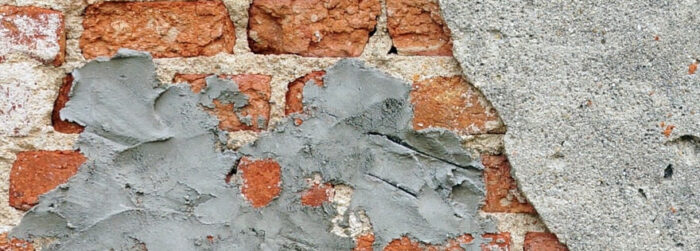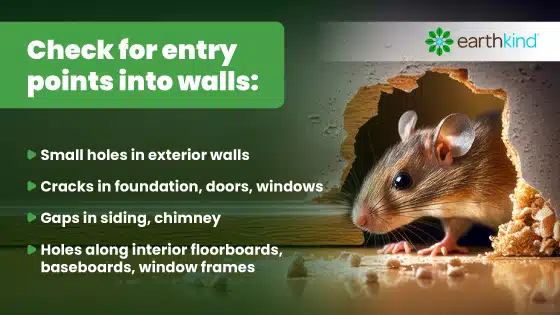What to Do About Mice in the Walls?
By : Rita Stadler
If you have ever experienced a mouse in the house—particularly one that’s gotten into your walls—you know the havoc they can wreak. The squeaking sounds they make in the middle of the night are enough to make you feel like you’re in the middle of a horror film.
Homeowners often think these little critters scurrying around inside the walls is better than inside the house. The reality is, mice that make their nest inside of your walls can cause serious damage to your home. They can make holes in the walls, eat through drywall, and chew on wiring, which creates a fire hazard. It’s important to identify the problem quickly and start working to get rid of these pests.
How Do Mice Get in Walls in the First Place?
Mice are tiny creatures and can manipulate their bones to become even smaller—allowing them to fit into a hole the size of a dime. They are excellent climbers and can climb pretty much any surface, allowing them to enter your home from either the ground or the roof.
If a mouse or rat finds an entry point into your walls, it’s likely they will nest there because they don’t have to worry about any other predators getting to them. If you suspect that there is a mouse problem in your walls, here’s how they may have gotten in:
- Holes in the exterior of your house. The exterior of the house is the most important place to check for small holes where these pests could find their way in. Once they’re in, they won’t want to leave the comfort of your warm home. Holes and openings to look for outside of the home include cracks in the foundation, doors, and windows. Look for gaps in siding, shingles, and chimneys.
- Openings in the interior of your house. Look for holes in floorboards, along the walls, along baseboards, and in window frames, and check for openings inside your pantries and cabinets. Also, be sure to look for signs of mice in places like your attic, air ducts, and crawl spaces.
Keep your home pest free with simple, effective solutions. Subscribe and save!
How to Get Rid of Mice in the Walls
While no one wants a mouse anywhere in their house, you really don’t want them in the walls of your home. Once they’re in there, they’ll be able to roam freely and chew their way through every room.
Stay Away® Rodent repellent should be your first line of defense for getting rid of mice in the walls. The repellent pouches are made using botanical ingredients and essential oils that create a fresh scent that smells pleasant to us, but repels mice and rats due to their heightened sense of smell. Place a few pouches around any suspected openings in your home to help get rid of these uninvited guests.
Keeping a clean home is also extremely important to getting rid of these pests. Making sure all crumbs are cleaned up from countertops and floors is essential. Another step is to store foods in airtight containers. These actions will help to remove their food sources and force them to look elsewhere in search of food. Look for water sources as well, such as in basements and under sinks. For more pest control tips, view our resource here.
Next, once you think the pests have exited your walls, mouse-proof your home by sealing up any openings you found during your inspection with steel wool and a sealant such as caulk. These sneaky pests won’t be able to find their way in again. It won’t be long before you’re on your way to a good night’s sleep.
Don’t Wait to Act on The Problem
Once you have heard the distinctive sounds of a mouse scratching and gnawing inside your walls, you’ll want to take action as quickly as possible. If the scary sounds aren’t reason enough, here are a few other facts that will convince you to get right on it:
- Mice attract mice. The smell of urine and feces will attract even more friends, and before you know it, you will have a mouse infestation.
- Reproduction speed. A female house mouse can have 5-10 litters of baby mice a year, producing 6-8 babies per litter.
- Long lifespan. Mice can live without water for months and without food for 1-2 weeks, but with access to both, they can live up to two years. And due to their constant reproduction, they can live in your walls indefinitely if measures aren’t taken to remove them.
- Odor. If there is a dead mouse in your wall, it’s a smell you’ll never forget, and until you remove the body, it’s something you’ll have to live with. It’s THAT strong. This is one reason why we advise against using mouse traps (such as poison, glue, or snap traps) or rodenticides because the pests die and may produce a strong odor that won’t go away until the trap is cleaned. Dead mice also attract fleas and bacteria.
- Diseases. Mouse droppings and urine not only have an unsightly appearance, but they can carry Hantavirus. Hantavirus can be transmitted to humans through breathing in contaminated air. This is a big reason to avoid live traps, such as baited traps that use peanut butter or cheese, because they can be very dangerous to handle.
- Fire hazards. There are lots and lots of electrical wires inside your walls. If these wires are chewed on — which they will be if there is a mouse roaming around — the chances of a fire starting are high.
- Damage. Along with wires being chewed on, the wood walls themselves will be damaged with chew holes and dampened from urine.
Finding a mouse repellent that not only gets rid of mice but prevents them from coming back is key. Check out Stay Away® Rodent online or in a store near you if you have a pest problem in your walls.









